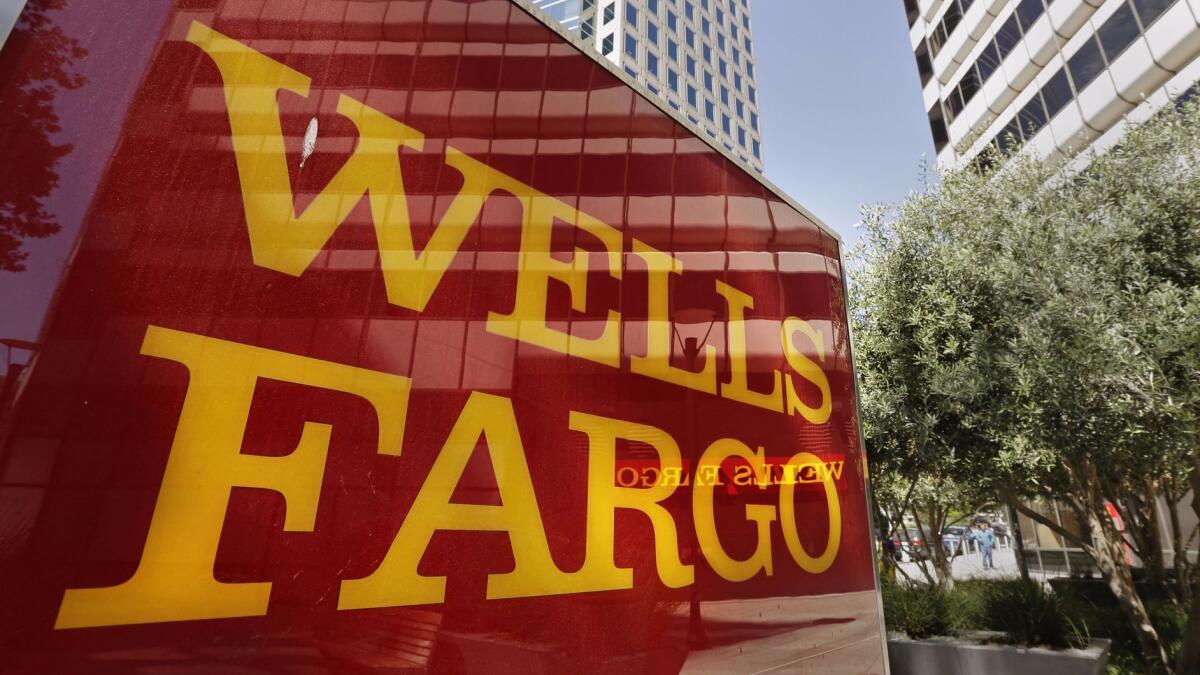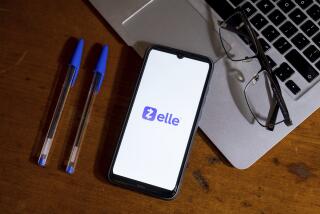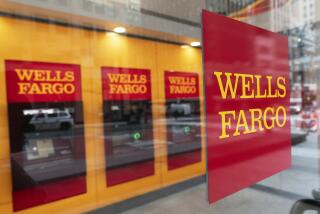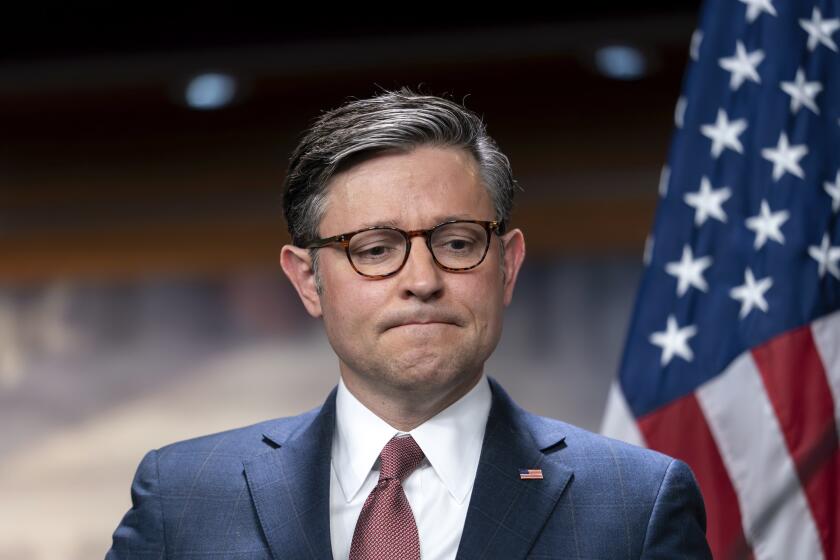Wells Fargo ups sham-account settlement to $142 million, making more customers eligible

- Share via
Wells Fargo & Co. has agreed to boost its payout in a class-action settlement over unauthorized accounts to $142 million, up from the $110 million it announced just three weeks ago, according to documents filed late Thursday.
The scandal-rocked bank agreed to the larger settlement after an internal report released last week showed that bank officials knew about unethical sales practices — including the creation of debit cards without customers’ authorization — as early as 2002.
The settlement as proposed last month would have covered customers who had unauthorized accounts opened for them in 2009 or later. Now the bank has added $32 million to the pot and agreed to pay customers affected by that practice going back to May 2002. A federal judge must still sign off on the deal.
Settlement documents filed in federal court in San Francisco late Thursday did not make clear how many customers may be eligible for the settlement or how many additional customers will be eligible because of the extension. The documents outline a process for how affected customers can make a claim for compensation, so the number of eligible settlement participants may grow.
The bank has said up to 2.1 million unauthorized checking, savings and other accounts were created, but that figure includes multiple accounts created for some individual customers.
Tim Sloan, the bank’s chief executive, said the expansion of the agreement was “an important step to make things right for our customers.”
“On our journey to rebuild trust, we want to ensure our customers feel confident that we have heard their concerns about retail sales practices, which includes offering them numerous opportunities for remediation,” he said in a statement released Friday.
But consumer advocates and attorneys for other Wells Fargo customers say the revised settlement still isn’t enough.
“A class-action settlement has to be big enough to punish them. I think, given the scale of the crime, the way they abused the public trust, it should be a bigger number,” said Ed Mierzwinski, consumer program director at the U.S. Public Interest Research Group. “For the amount of hassle and the amount of outrage Wells Fargo caused, they’re getting off cheap.”
The bank’s agreement to the new terms comes just ahead of the company’s annual shareholder meeting, which is to be held at a Florida resort on Tuesday.
Investment advisory groups and California’s state treasurer have called on investors to vote against many of the company’s board members to chide them for lax oversight of the bank in the years leading up the the scandal.
The proposed settlement is the result of negotiations between Wells Fargo and attorneys at Seattle law firm Keller Rohrback, who represent a handful of bank customers from across the country.
In that case, filed two years ago in federal court in San Francisco, plaintiffs alleged that bank workers, driven by onerous sales goals, opened accounts for customers without authorization — precisely the kind of conduct that the Los Angeles Times first reported in 2013 and that Wells Fargo has since admitted to.
The $142-million settlement calls for making different kinds of payments to customers depending on how they were affected by the unauthorized accounts.
Customers who paid fees related to the accounts would get refunds, but only if they haven’t received refunds already. Customers who say their credit was damaged by unauthorized accounts — either by unwanted credit inquiries or by debts caused by hidden fees — would be paid back for added costs, a process that will involve checking customer credit scores.
Customers will have to show that their credit was harmed and they took out a loan at a higher interest rate to be eligible for repayment of the extra costs.
Any settlement funds left over after refunds and credit-related payments will be split up among eligible customers, based on the number of unauthorized accounts they had.
The settlement would put an end to the 2015 lawsuit, Jabbari et al vs. Wells Fargo & Co., but would apply to all customers who had unauthorized accounts opened in their name.
That means the settlement, if approved by U.S. District Judge Vince Chhabria, would effectively put an end to nearly a dozen similar cases filed across the country in the months after the bank’s misdeeds came to light last year.
Now that the settlement plan has been filed, attorneys representing plaintiffs in other cases can have until May 4 to voice their support or opposition to the proposed deal. A hearing on the proposal is scheduled for May 18.
Last month, some attorneys said they would object, saying the original $110 million Wells Fargo agreed to pay was too low and that customers could get a better deal if they continued to fight the bank in court. That argument could continue, even with the larger settlement sum.
Christopher Hood, a Birmingham, Ala., attorney who is representing plaintiffs in two federal cases against the bank, said Friday he was still reviewing the new settlement proposal. He said that it’s impossible to know whether this amounts to a good deal because it’s not clear how many customers will be compensated or how much they will get.
“It’s conspicuous that they still don’t know or won’t say how many members of the class there are,” Hood said.
Mierzwinski agreed, and noted that the settlement amount was increased because of new information that was recently released in the bank’s internal report.
With several federal and state agencies — including the U.S. Department of Justice and the California attorney general’s office — still investigating the bank, Mierzwinksi said it’s possible that more information could come out that would push the bank to go still higher.
“We shouldn’t close the door this soon for this little,” he said.
Customers so far have had limited success in suing the bank. When customers open Wells Fargo accounts, they sign a contract that requires customers to settle disputes with the bank in private arbitration rather than in court.
Chhabria and some state court judges have ruled that those arbitration agreements mean that customers must go to arbitration, even if they allege the bank created unauthorized accounts in their name.
Despite that, attorneys in other jurisdictions say they believe their cases might be allowed to proceed in court rather than being pushed into arbitration.
Attorneys at Keller Rohrback addressed that issue in Thursday’s filing, saying that the odds of any court case being allowed to proceed is low and that the settlement represents the best deal bank customers are likely to get.
Twitter: @jrkoren
UPDATES:
12:10 p.m.: This article was updated with more details from the proposed settlement and comments from attorney Christopher Hood and Ed Mierzwinski of the U.S. Public Interest Group.
6:45 a.m.: This article was updated with an estimate of the number of sham accounts created by the bank.
6:25 a.m.: This article was updated with a statement from Wells Fargo Chief Executive Tim Sloan.
This article was originally published at 6:20 a.m.
More to Read
Inside the business of entertainment
The Wide Shot brings you news, analysis and insights on everything from streaming wars to production — and what it all means for the future.
You may occasionally receive promotional content from the Los Angeles Times.










